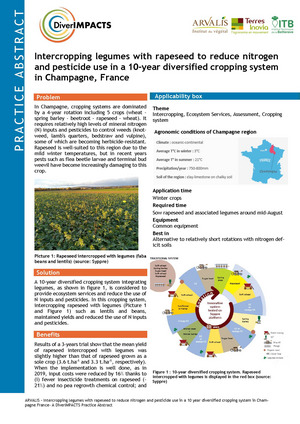Intercropping legumes with rapeseed to reduce nitrogen and pesticide use in a 10-year diversified cropping system in Champagne, France
Authors: Pierre Rochepeau, Gilles Sauzet
Problem: In Champagne, cropping systems are dominated by a 4-year rotation including 5 crops (wheat - spring barley - beetroot – rapeseed – wheat). It requires relatively high levels of mineral nitrogen (N) inputs and pesticides to control weeds (knotweed, lamb's quarters, bedstraw and vulpine), some of which are becoming herbicide-resistant. Rapeseed is well-suited to this region due to the mild winter temperatures, but in recent years pests such as flea beetle larvae and terminal bud weevil have become increasingly damaging to this crop.
Solution: A 10-year diversified cropping system integrating legumes is considered to provide ecosystem services and reduce the use of N inputs and pesticides. In this cropping system, intercropping rapeseed with legumes such as lentils and beans, maintained yields and reduced the use of N inputs and pesticides.
English:
zenodo.org: Intercropping legumes with rapeseed to reduce nitrogen and pesticide use in a 10-year diversified cropping system in Champagne, France
French:
zenodo.org: Associer le colza avec des légumineuses pour contribuer à la réduction des intrants dans un système de cultures diversifié en Champagne

 Souhaitez-vous ajouter le site web à l'écran d'accueil ?
Souhaitez-vous ajouter le site web à l'écran d'accueil ?